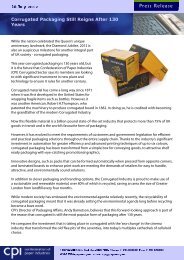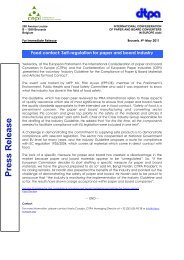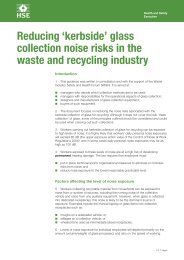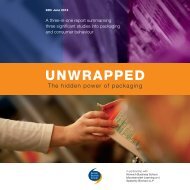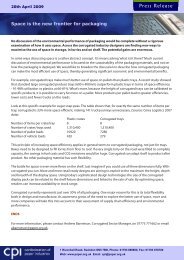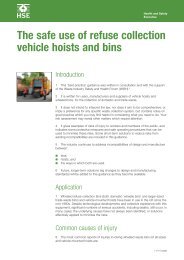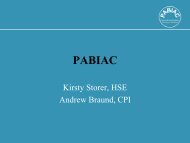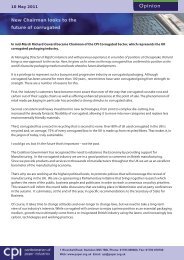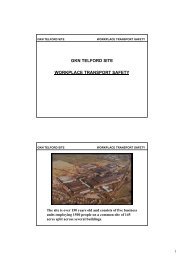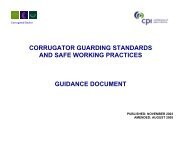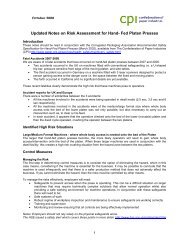Industry guideline for the Compliance of Paper & Board ... - cepi
Industry guideline for the Compliance of Paper & Board ... - cepi
Industry guideline for the Compliance of Paper & Board ... - cepi
Create successful ePaper yourself
Turn your PDF publications into a flip-book with our unique Google optimized e-Paper software.
This Guideline considers <strong>the</strong> specific nature <strong>of</strong> food contact paper and board with regard to<br />
<strong>the</strong> following aspects:<br />
1. <strong>Paper</strong> and board consists predominantly (around 99%) <strong>of</strong> cellulose fibres, naturally<br />
occurring minerals such as calcium carbonate, and natural polymers such as starch.<br />
Cellulose itself is a natural polymer based mainly on glucose units. The properties<br />
required <strong>of</strong> specific paper grades are obtained by adding chemicals that are in most<br />
cases used in amounts significantly less than 1% by weight <strong>of</strong> <strong>the</strong> paper and board. There<br />
are two categories <strong>of</strong> chemicals added:<br />
• Functional additives that are intended to stay in <strong>the</strong> paper and board in order to<br />
achieve a technical effect.<br />
• Process chemicals or processing aids that are used to improve <strong>the</strong> efficiency <strong>of</strong> <strong>the</strong><br />
papermaking process. These chemicals are not intended to stay in <strong>the</strong> paper and<br />
board and are usually washed out during <strong>the</strong> papermaking process.<br />
2. <strong>Paper</strong> and board <strong>for</strong> food contact is different from plastics where most legislative<br />
provisions have so far been concentrated. For instance:<br />
• It has low consumer exposure due to <strong>the</strong> low proportion <strong>of</strong> all direct contact food<br />
packaging, where <strong>the</strong> main application is contact with dry food.<br />
• It has a completely different manufacturing process compared to plastics.<br />
• Its predominant base polymer is cellulose whose monomer, ß-glucose, has no known<br />
adverse health issues.<br />
• Standard migration test methods used <strong>for</strong> plastics are not easily applicable or not<br />
appropriate <strong>for</strong> control.<br />
For <strong>the</strong>se reasons regulation and control <strong>of</strong> paper and board <strong>for</strong> food contact using <strong>the</strong><br />
“plastics” approach with control <strong>of</strong> numerous specific migration limits does not appear<br />
to be <strong>the</strong> most suitable. The already existing and widely used Recommendation XXXVI<br />
(plus parts I, 2 and 3) <strong>of</strong> <strong>the</strong> German BfR (Bundesinstitut für Risikobewertung, see Annex<br />
1) sets compositional limits and seems to be a more appropriate basis <strong>for</strong> regulation and<br />
control. This Recommendation is also referred to in o<strong>the</strong>r national requirements, e.g. <strong>the</strong><br />
French “Guide de Bonnes Pratiques”. The methodology in this Guideline is based on this BfR<br />
Recommendation, although substances which are <strong>the</strong> subject <strong>of</strong> o<strong>the</strong>r approvals may also<br />
be permitted (see Annex 1). Also introduced is a larger element <strong>of</strong> final product testing and<br />
specific requirements <strong>for</strong> <strong>the</strong> control <strong>of</strong> recovered paper.<br />
Issue 1 <strong>of</strong> this Guideline was <strong>the</strong> subject <strong>of</strong> an independent peer review,<br />
carried out by Pira International.<br />
The entire peer review can be downloaded at<br />
http://www.<strong>cepi</strong>.org/topics/foodcontact/publications/peerreview<br />
2



